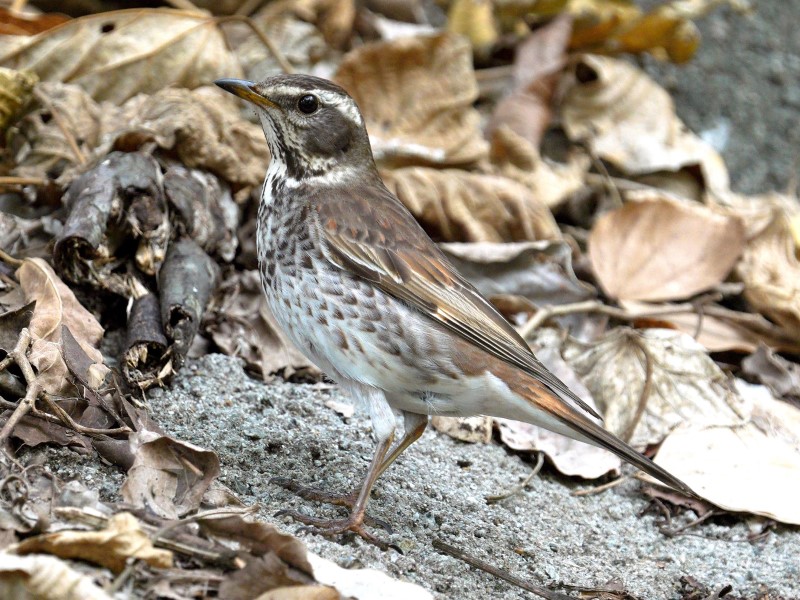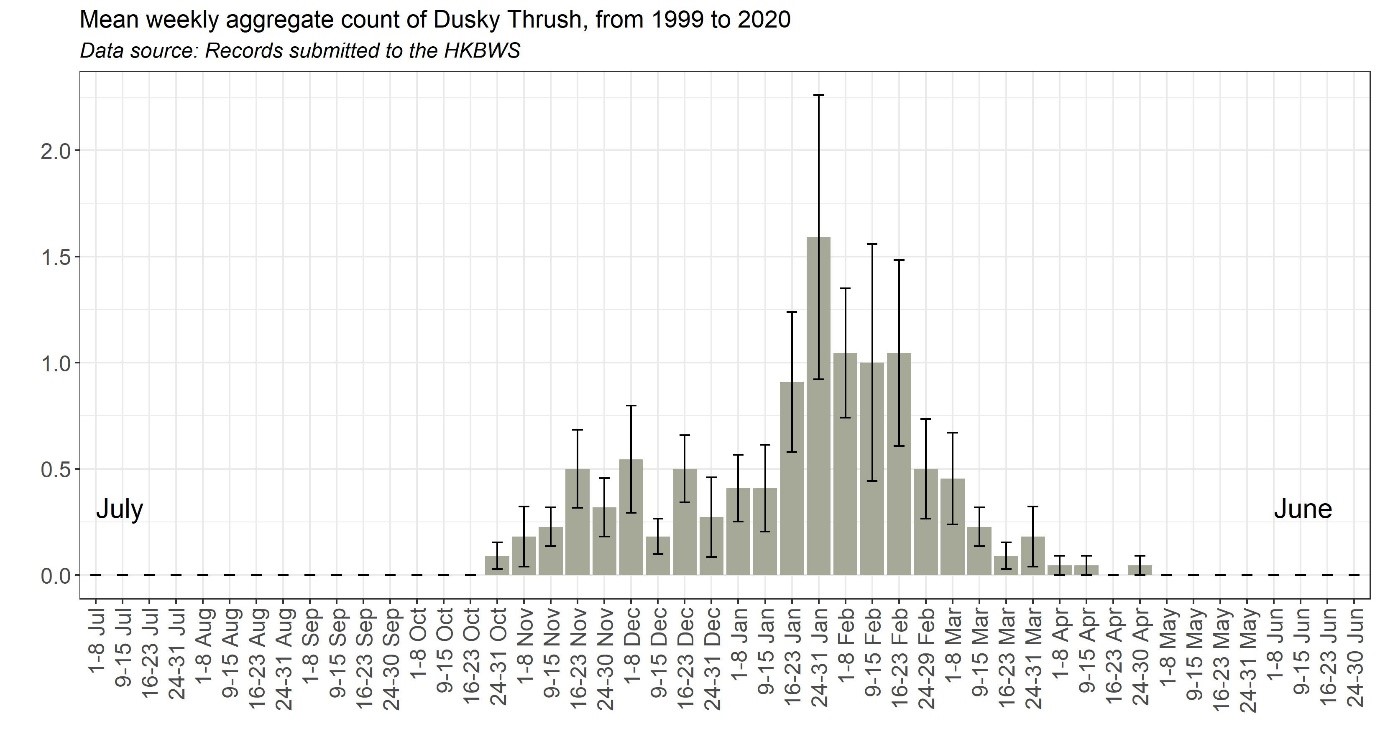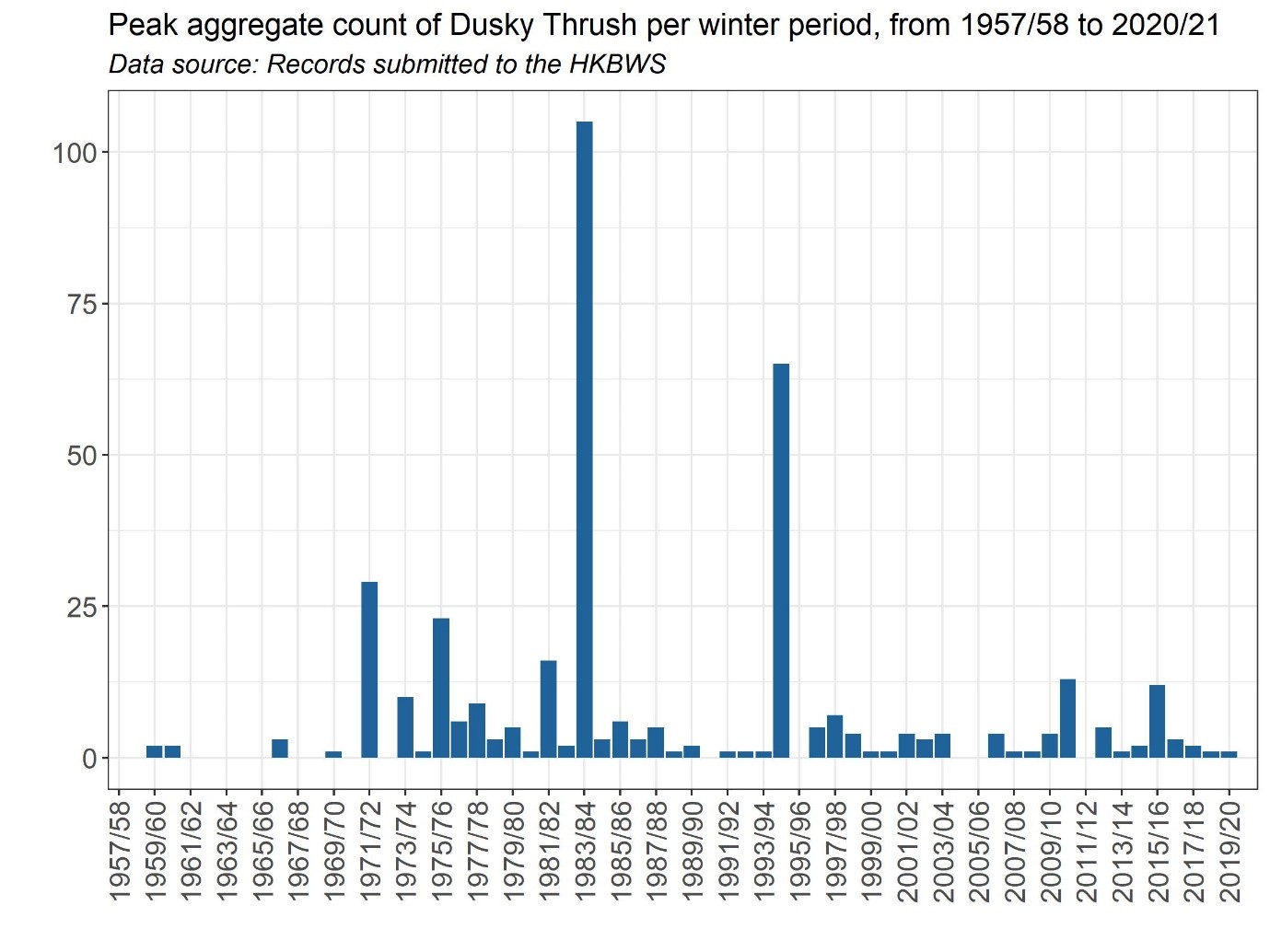Dusky Thrush Turdus eunomus 斑鶇
Category I. Scarce winter visitor subject to cold weather influxes when it may be uncommon. Occurs in open country habitats or areas of open or scattered woodland.
IDENTIFICATION

Jan. 2010, Michelle and Peter Wong. First-winter male.
21-24 cm. Rufous inner greater coverts contrasting with duller juvenile outer greater coverts indicates this is a first-year bird. The adult male is moderately dark greyish above and below, with a contrasting rufous panel in the wing formed by greater coverts, tertials and edges to flight feathers, and a whitish supercilium, throat and half-collar.

Nov. 2014, Koel Ko. Adult female.
Adult males appear to be rare in HK. This adult female has uniformly patterned greater coverts indicating age and limited rufous in the wings indicating sex.

Mar. 2022, Roman Lo. First-year female.
The dull upperparts, dull rufous in the greater coverts and a lack of heavy blackish on underparts indicates this is a female. The replaced inner greater coverts indicates a first-year.
Intergrades frequently occur with Naumann’s Thrush, many of which resemble Dusky Thrush but have deep copper-brown upperparts and golden-brown wing coverts (Collar and de Juana 2020) and may have rufous on the underparts.
VOCALISATIONS
A quite loud often double or triple-note call is uttered in flight, quite different from other thrushes occurring in HK apart from Naumann’s Thrush.
DISTRIBUTION & HABITAT PREFERENCE
Occurs in open country habitats, including wet and dry agricultural areas such as Long Valley, golf courses, mixed agricultural and low-density residential areas such as Lam Tsuen, fish ponds, managed wetlands, freshwater marsh and large channelised watercourses. The northwest New Territories sees most records, with Long Valley a relatively favoured site.
OCCURRENCE
Although extreme dates for this species are 28 October 2001 and 5 May 1989, 64% of records have occurred from the beginning of the year to the first week of March (Figure 1). This and an irregular and irruptive pattern of occurrence indicates that many birds arrive here as a response to cold weather further north. Figure 2 indicates that most records occurred in only two winter periods: 1983/84 and 1994/95. At a former marshy area at Ha Tsuen in the northwest New Territories a flock of at least 100 birds, the highest single count for HK, was present on 18 February 1984.
Such a long gap since the last of these irruptions and the fact Dusky Thrush was generally more numerous in the 1970s and early 1980s at a time of substantially less observer activity probably indicates an impact on this northerly species of milder winters arising from climate warming.
Dusky Thrush was first recorded on 4 February 1956 (Walker 1958); it was only recorded in two winter periods in the 1960s, but nearly annually since winter 1971/72.
BEHAVIOUR, FORAGING & DIET
A mobile and vocal thrush of open-country areas that forages both on the ground and in fruiting trees or shrubs, but no details on food items. Often sits in the open in bare trees.
RANGE & SYSTEMATICS
Monotypic. Breeds in north and northeast Siberia east to the Sea of Okhotsk, including the Kamchatka peninsula; winters in much of Japan, the Korean Peninsula, south China and northern Indochina (Collar and de Juana 2020). In China a winter visitor south of the Chang Jiang (Yangtze River) (Liu and Chen 2021).
CONSERVATION STATUS
IUCN: Least Concern. Population trend unknown.
Figure 1.

Figure 2.

Collar, N. and E. de Juana (2020). Dusky Thrush (Turdus eunomus), version 1.0. In Birds of the World (J. del Hoyo, A. Elliott, J. Sargatal, D. A. Christie, and E. de Juana, Editors). Cornell Lab of Ornithology, Ithaca, NY, USA. https://doi.org/10.2173/bow.dusthr2.01
Liu, Y. and S. H. Chen (eds) (2021). The CNG Field Guide to the Birds of China (in Chinese). Hunan Science and Technology Publication House, Changsha.
Walker, F. J. (1958). Field observations on birds in the Colony of Hong Kong. Hong Kong Bird Watching Society, Hong Kong (duplicated).

